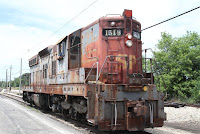I was out at IRM on Saturday rather than my usual Sunday trip because of a "Take the Throttle" (sort of) trip with the 319. I say "sort of" because it wasn't part of the museum's normal "Take the Throttle" program, but rather was a trip run for a man who had donated a significant sum to the Brookins collection acquisition a few years back and who also brought out several historic CA&E items to donate.
With help from Zach Ehlers and Museum President Joe Stupar, I took the 319 out in the morning. The 36, which was at the door and is still a control trailer pending a new grid box, was shoved out to the tail track and set out there. Our donor, pictured above, ran a trip with the 319 and did rather well I'd say. If you're interested in running an electric car (or a diesel locomotive) just call the IRM office to make arrangements!
Upon our arrival there was a big enough crowd at the depot that Zach and I ran a single revenue trip as well. The car was quite full, which was nice, and people didn't seem to mind that we were dressed in shop clothes rather than proper uniforms.

Note that they're different, and I don't just mean the rather artsy C-6 shadow on one. One has a hand latch set into it while the other, possibly rebuilt at Wheaton, doesn't. These are the same design traps as used on North Shore cars but, while the North Shore used these hand latches that sit flush with the trap floor surface, the CA&E had a better system. On the Jewetts and the steel cars there's a foot pedal mounted to the floor next to the trap. All you have to do is step on the pedal and the trap springs up. In theory, you don't even have to bend down to open it. Pretty slick, eh? On traps that also have a hand latch, the latch is simply fastened shut and not used.
I also cleaned up the end castings for the 36 grid box, so it's ready to repaint. After a few hours of needle chipping I put the 319 and 36 back in Barn 8 and did some walking around to see what was happening. Tim was hard at work on the gate car and had just gotten the lights in the rooftop signs and marker lights at the "deep cab" end of the car working. (The car has a cab at both end but one is two windows deep and originally contained the air compressor.) Bill was helping him out while Eric was over working on the Cleveland PCC.
And as evening approached the 'L' car guys were switching 'L' cars. Dave Fullarton and Richard Schauer, along with a new volunteer whose name I failed to get, were setting up a photo shoot with our three pairs of "high performance" cars: the 2000s, 2200s and 2400s, now all fully operational. First the two newer sets were brought out of 50th Avenue; above Dave works on getting that perfect shot.
And then the 2000s were run over from Barn 8. Here Richard, the new guy, Dave, and Bill do some final polishing. Let it not be said that we pay attention to details!And here's my crew from the morning, Zach and Joe, observing the 'L' car festivities along with me. When putting the cars away there was an issue with coupling the 2200s and 2400s. I commented to Joe that problems with coupling seemed to be a theme today! But as with earlier in the day, the issue was quickly rectified and all is well with the modern 'L' car fleet. I think it was Richard who made the comment that these six cars can probably make the longest "all cars powered" electric train IRM has ever run; even with our seven-car train of 6000s from a few years ago only four or five of the cars were motoring and we've never run more than a five-car interurban train.






















































